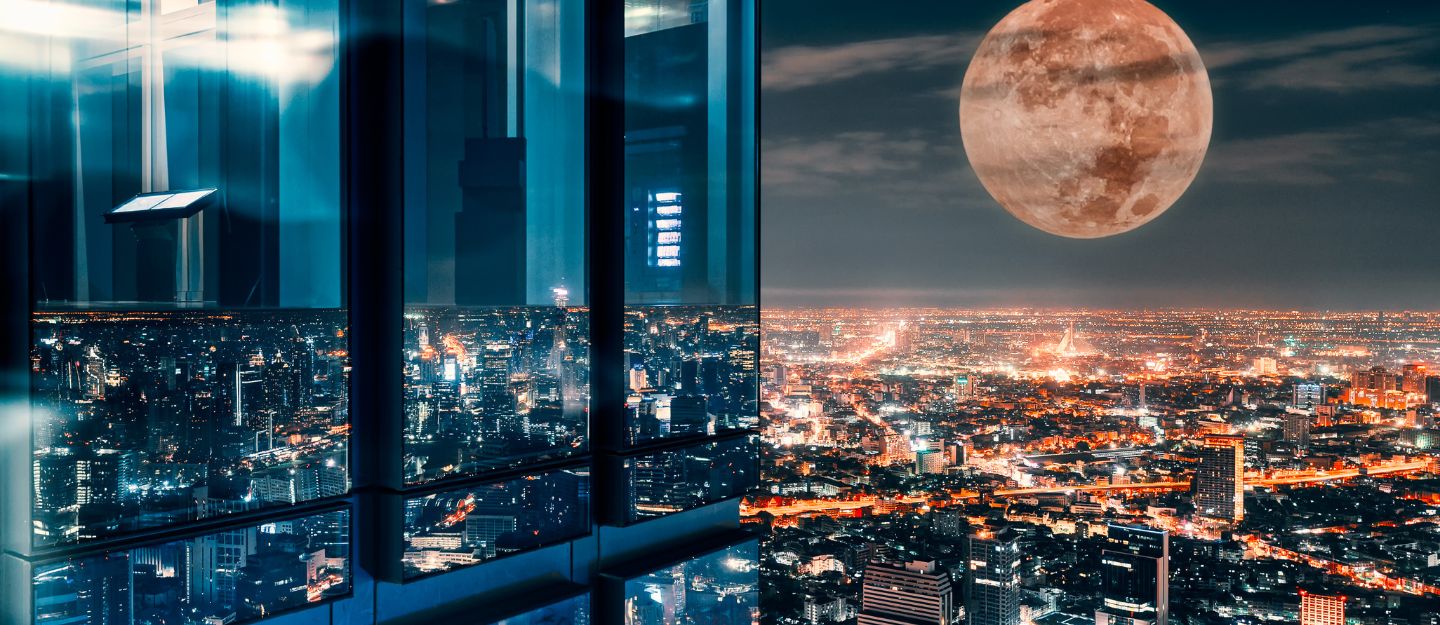Spectacular UAE astronomical events calendar for 2025
The vast, clear skies in the UAE offer perfect conditions for witnessing remarkable cosmic phenomena. While several breathtaking astronomical events have already occurred this year, numerous spectacular astronomical and cosmic events in Dubai and the rest of the UAE are still to come in the last quarter of 2025.
UAE astronomical events calendar for Q4 2025 – Supermoons
From magnificent supermoons to dazzling meteor showers and rare planetary alignments, the astronomical calendar for the remainder of 2025 would appeal to both casual sky-watchers and dedicated astronomers.
Whether you’re planning to observe with the naked eye or through sophisticated telescopes, this comprehensive guide to astronomical and cosmic events in Dubai will help you prepare for the most anticipated celestial events to come in the UAE this year.
Beaver Supermoon: November’s Lunar Spectacle on November 5th
What are the dates of the next supermoons and lunar eclipses in Dubai?
The celestial astronomy calendar for Dubai continues with another impressive lunar display on November 5th, featuring the Beaver Supermoon. Like October’s Hunter Supermoon, this full moon coincides with the moon’s closest approach to Earth.
The name “Beaver Moon” reflects traditional associations with the time of year when beavers become particularly active, building their lodges in preparation for winter.
This supermoon will be visible from anywhere in the UAE with a clear horizon, though the experience is enhanced when viewed from locations with minimal/light pollution.
Cold Moon: The Final Supermoon of 2025 on 4th December
The year’s final supermoon, known as the Cold Moon, will be visible on 4th December. This name aptly reflects the winter season, with enjoyable temperatures that allow for extended outdoor stargazing in Dubai, unlike the summer months.
Like other supermoons in the UAE, the Cold Moon will appear larger and brighter than usual as it reaches its closest point to Earth in its elliptical orbit.
For a truly memorable experience, consider heading to elevated locations like Jebel Jais in Ras Al Khaimah or the expansive desert of Al Qudra. The Dubai Astronomy Group often organises special viewing events for significant astronomical and cosmic events in Dubai, providing expert guidance and access to telescopes.
Previous astronomical and cosmic events in Dubai: Hunter’s Supermoon on October 7th
Hunter’s Supermoon, the largest supermoon in Dubai of 2025, illuminated the UAE skies on October 7th. This extraordinary lunar event combines a full moon with its closest approach to Earth (perigee), resulting in a moon that appears approximately 14% larger and 30% brighter than a typical full moon.
Regarding facts about the supermoon, Hunter’s Supermoon derives its name from traditional hunting practices — as October historically marked a time when hunters would prepare for the approaching winter by gathering food.
Planet Oppositions
Jupiter Opposition: The Gas Giant at Its Brightest on 7th December
When is the next Jupiter or Saturn opposition visible from Dubai?
Just days after the Cold Moon, on 7th December, Jupiter will reach opposition, offering another spectacular viewing opportunity for planetary alignments in Dubai. During opposition, Jupiter stands directly opposite the Sun from Earth’s perspective, making it appear at its brightest and largest for the year.
Through even a modest telescope, observers can distinguish Jupiter’s atmospheric bands and its four largest moons—Io, Europa, Ganymede and Callisto. Some observers may even catch a glimpse of the famous Great Red Spot, a massive storm system larger than Earth that has persisted for centuries on the gas giant.
Which planets will align or be visible to the naked eye this year?
Jupiter will be visible throughout the night during this period, rising at sunset and setting at sunrise. For the best viewing experience, consider joining an organised astronomical event or visiting locations with minimal light pollution. The Sharjah Centre for Astronomy and Space Sciences and Al Sadeem Astronomy in Abu Dhabi occasionally host public viewing sessions for significant astronomical events.
Meteor showers astronomical events
Orionids Meteor Shower: Halley’s Comet Debris Will Create Celestial Fireworks on October 21st and 22nd
What major astronomical events can you see from Dubai in 2025?
The nights of October 21st and 22nd will feature the Orionids meteor shower in Dubai, an annual display created when Earth passes through debris left behind by the famous Halley’s Comet. This meteor shower is renowned for producing fast-moving meteors that travel at approximately 66 km per second, often leaving glowing trails that linger momentarily in the night sky.
Which meteor showers will be visible from the UAE this year?
Under ideal conditions, observers in the UAE can expect to witness up to 20 meteors per hour during the peak period. Dubai’s best observation times will be after midnight until dawn, when the shower’s radiant point in the constellation Orion rises high in the sky. Unlike some astronomical events that require special equipment, meteor showers are perfectly visible to the naked eye.
When are the upcoming meteor showers visible from Dubai?
For optimal viewing, seek locations far from urban light pollution, such as Al Quaa in Abu Dhabi or the desert areas around Al Qudra. Bring comfortable seating or a blanket to lie on, as meteor watching requires patience and a wide field of view. Remember, no telescopes or binoculars are needed.
Leonids Meteor Shower: Cosmic Debris Will Create a Celestial Light Show on 17th and 18th November
On 17th and 18th November, the Leonids meteor shower will paint streaks of light across the UAE skies. This annual meteor display occurs when Earth passes through debris left by Comet 55P/Tempel-Tuttle, creating a natural light show as tiny particles burn up in our atmosphere.
While the Leonids are historically known for occasionally producing spectacular meteor storms with thousands of meteors per hour, the 2025 display is expected to be more modest, with approximately 10 to 15 meteors visible per hour under ideal conditions. Nevertheless, the Leonids are known for producing bright meteors that often leave persistent trains, making for impressive viewing even with lower numbers.
How can families and kids experience astronomy in Dubai?
As with all meteor showers, the best viewing experience comes from finding a dark location away from city lights and allowing your eyes at least 20 minutes to adapt to the darkness. The shower is named after the constellation Leo, from which the meteors appear to radiate, although they can be seen anywhere in the sky. Peak viewing will be after midnight when the radiant rises higher in the eastern sky.
Geminids Meteor Shower: The Year’s Grand Finale on 13th and 14th December
The astronomical year concludes with one of its most spectacular displays—the Geminids meteor shower, peaking on 13th and 14th December. Unlike most meteor showers attributed to comets, the Geminids are debris from an asteroid named 3200 Phaethon, which creates one of the most reliable and abundant meteor showers of the year.
Under ideal conditions, observers in the UAE might witness up to 120 meteors per hour during peak activity. What makes the Geminids particularly special is their often colourful appearance, with meteors displaying yellow, green, blue and even red hues due to their mineral composition. Additionally, Geminid meteors move more slowly across the sky than those in other showers, making them easier to spot and appreciate.
How can I photograph night sky events around Dubai?
For the best experience, head to dark-sky locations like Al Quaa in Abu Dhabi, Al Qudra in Dubai or the mountains of Ras Al Khaimah. The shower is visible throughout the night, though peak activity typically occurs around midnight. No special equipment is needed. Find a comfortable spot away from lights, lie back and take in the celestial fireworks that mark the end of an extraordinary year of astronomical events in the UAE.
FAQs
What are the best places to view stars in the UAE?
Best places to view stars in the UAE include Al Barsha Pond Park, Al Qudra Lakes, Hatta Dubai, Jebel Ali Beach, The Observation Deck, Dubai Creek Harbour and Al Quaa Milky Way Viewing Point, Abu Dhabi.
Are there public telescopes or astronomy clubs in Dubai?
You can contact Al Thuraya Astronomy Centre or participate in Dubai Astronomy Group events to witness astronomical events.
Where can I view the supermoon in Abu Dhabi?
For those seeking a more adventurous and rugged supermoon in Abu Dhabi viewing experience, make your way to Al Quaa, which is situated about 90 minutes from Abu Dhabi in the direction of Al Ain.
Renowned within stargazing circles as an excellent site for astrophotography, this desert location necessitates the use of a 4×4 vehicle. Still, the journey is worthwhile as it offers skies that are almost free from light pollution.
Why are photographers excited about astronomical and cosmic events in the UAE?
For photographers, a supermoon in the UAE presents a prime opportunity to capture dramatic images, particularly during moonrise just after sunset. This is when the moon appears largest to human perception due to an optical illusion.
Whether you’re a dedicated astronomer or simply curious about the wonders above, the UAE’s clear skies and diverse viewing locations make it an exceptional place to witness these celestial spectacles.
Consider joining organised viewing events through the Dubai Astronomy Group or other astronomical organisations for expert guidance that will enhance your stargazing experience throughout the remainder of 2025.
To learn more about the latest happenings in the UAE, subscribe to MyBayut!









